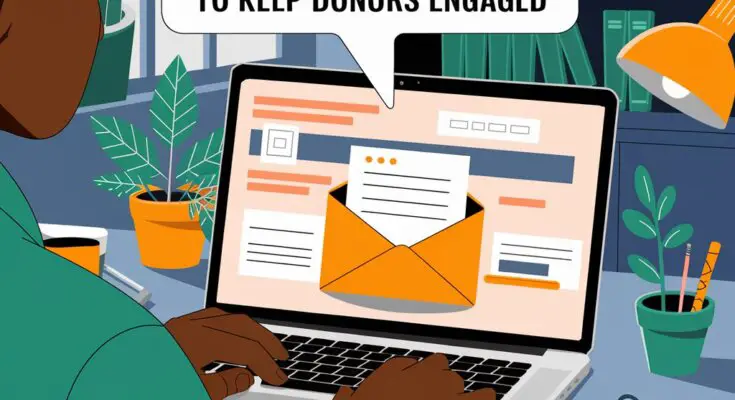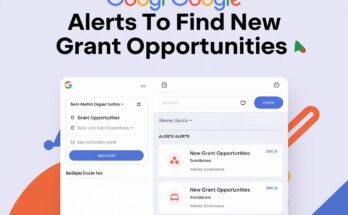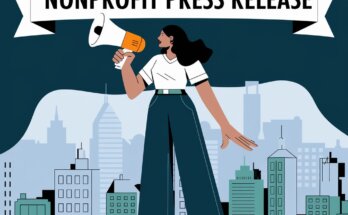How to Use Email Newsletters to Keep Donors Engaged—this is one of the biggest questions nonprofit leaders often ask when looking to build stronger connections with their supporters.
In today’s fast-paced digital world, email newsletters are powerful tools for keeping donors engaged and nurturing relationships over time. However, if not used effectively, newsletters can become just another email lost in a crowded inbox.
In a world where digital communication reigns supreme, staying connected with your donors is more crucial than ever.
Email newsletters have emerged as a vital lifeline for nonprofits looking to maintain and strengthen relationships with their supporters.
But how can you effectively use these newsletters to keep your donors engaged?
This post will explore practical strategies that will help your organization maximize the impact of your email communications, providing relatable examples and engaging stories along the way.
Get ready to unlock the potential of your email newsletters and cultivate a vibrant community of dedicated supporters!
Why Email Newsletters Matter
Before we delve into strategies, let’s understand why email newsletters are crucial for donor engagement.
- They allow you to communicate directly with your audience without the clutter of social media algorithms getting in the way. Second,
- They are a cost-effective way to share updates, success stories, and calls to action with your supporters.
- Most importantly, newsletters build community, letting donors feel like they are part of something bigger.
1. Start with a Personal Touch
When crafting your email newsletters, the first step is to make it personal. Donors are much more likely to engage with content that feels like it was created just for them. This means addressing each supporter by their name and tailoring your message to their specific interests.
Example: Imagine you’re a nonprofit focused on environmental conservation. For a donor who has supported tree-planting projects, you might start your newsletter like this: “Hi Sarah, thanks to your amazing support, 500 trees have been planted in the last three months! We couldn’t have done it without you!”
Tip: Use your donor database to segment your newsletter list by interests. Send updates on specific programs to the donors who have shown interest in those areas. This makes each email feel more relevant and personalized, boosting open rates and engagement.
2. Tell Compelling Stories
Stories have a unique way of connecting with readers on an emotional level. When you share a story, it helps your donors see the real-world impact of their contributions. In fact, a compelling story can often be the difference between a quick skim and a deep read.
Example: Let’s say your organization supports education for underprivileged children. Share a story about a student who has benefited from your programs. Describe their journey, the challenges they faced, and how your nonprofit (and the donor’s support) made a difference.
For instance, you might write, “Meet Daniel, a bright 10-year-old with a love for learning. Thanks to your donations, Daniel is now attending school and dreams of becoming a doctor one day.”
3. Use Impactful Data
Donors want to know that their support is making a difference. Including data and metrics in your newsletter can help you demonstrate the tangible impact of their contributions. Think of numbers as another form of storytelling, offering concrete proof of progress.
Example: “In 2023, thanks to generous donors like you, we provided 2,000 meals to families in need, delivered 500 educational kits to students, and planted 1,000 trees. Your support matters!” Use simple infographics or visuals to make the data more digestible and engaging.
4. Keep It Consistent
One of the biggest factors in keeping donors engaged is consistency. Decide on a regular newsletter schedule—whether monthly, quarterly, or bi-monthly—and stick to it. Consistency builds trust and lets donors know they can expect valuable updates from you.
Example: If you commit to a monthly newsletter, make sure it goes out on the same day each month, like the first Monday. Consider adding a recurring section, such as “Impact Snapshot” or “Volunteer Spotlight,” so readers know what to look forward to each time.
5. Add a Clear Call-to-Action (CTA)
Every email newsletter should include a clear call-to-action (CTA). Whether it’s inviting donors to an event, asking them to share the newsletter with friends, or encouraging them to make another donation, a CTA guides your readers on what to do next.
Example: After sharing a story or impact update, add a CTA that says, “Help us continue this work—donate today!” or “Join us for our upcoming virtual event to learn more.” Make your CTA bold and easy to spot, ensuring it stands out in your email.
A Donor’s Journey
Let’s pause for a moment to share a story that illustrates the power of a well-crafted newsletter.
Meet Emma, a dedicated supporter of a nonprofit that provides clean water access to communities in need. Emma loved the cause, but over time, she felt somewhat disconnected from the organization. She wondered if her monthly donations were truly making a difference.
One day, Emma received a newsletter with the subject line, “You Made Clean Water Possible.” Curious, she opened it and was met with a powerful story about a village where clean water had transformed lives.
There were photos of families gathered around the new water well, as well as data showing how many cases of waterborne illness had decreased. Emma read every word, and by the end, she felt a renewed sense of purpose.
In the next issue, the newsletter featured an invitation to a virtual event where Emma could meet the nonprofit’s field team and hear more stories.
She joined the event, learned even more about the impact of her support, and even decided to increase her monthly donation. Emma became not just a donor, but a true advocate, sharing the nonprofit’s newsletters with her friends and encouraging them to donate, too.
6. Celebrate Milestones and Achievements
Donors love being part of a winning team. When your nonprofit reaches a significant milestone, share the excitement in your newsletter! Celebrating achievements helps build a sense of pride and community among your supporters.
Example: If you’ve hit a major fundraising goal, dedicate a section of your newsletter to celebrating this milestone. “Thanks to you, we raised $50,000 for our new youth center! Here’s what we’ve accomplished so far—and we’re just getting started!” Include visuals, like photos from a recent event or a picture of the new facility under construction.
7. Spotlight Donors and Volunteers
Recognizing donors and volunteers in your newsletter is an effective way to build community. Consider adding a Donor Spotlight or Volunteer of the Month feature. It makes supporters feel valued and appreciated.
Example: Highlight a long-time donor, sharing why they’re passionate about your cause and how their contributions have made a difference. “This month, we’re honoring Lisa, who has supported us for over five years. Lisa’s passion for animal welfare inspires us daily, and we’re so grateful to have her on our team.”
8. Use Exclusive Content
Providing exclusive content in your newsletters can make subscribers feel special and more engaged. Offer behind-the-scenes looks, interviews with staff, or sneak peeks of upcoming projects.
Example: Share a behind-the-scenes look at how your organization prepared for a big event. “Before our annual gala, our team put in countless hours to make it a success. Here’s a look behind the scenes, and a sneak peek of next year’s theme!”
9. Incorporate Interactive Elements
Donors want to feel like they’re part of the mission, not just observers. Encourage interaction by adding elements that let them engage directly with your nonprofit.
Example: Include a small survey in your newsletter with questions like, “What types of stories do you enjoy most?” or “What topics would you like us to cover in future newsletters?” This not only encourages engagement but also provides you with valuable insights.
10. Encourage Social Sharing
The easiest way to expand your reach is by encouraging your current donors to share your content. Make it easy for them to forward the newsletter to a friend or share it on social media.
Example: At the end of your newsletter, include a line like, “Know someone who would love our mission? Forward this email to them!” or “Share our newsletter on social media and help spread the word about our cause!”
11. Ask for Feedback
Feedback is one of the most valuable resources for improving your donor communication strategy. Asking for feedback not only shows that you care about your donors’ opinions but also opens the door for valuable insights into what works and what doesn’t.
Example: Include a section at the end of your newsletter that says, “How are we doing? Let us know what you think of our newsletter! Your feedback helps us create better content for you.” Add a link to a short survey to make it easy for them to respond.
Next Step
Keeping your donors engaged through email newsletters isn’t just about sharing updates—it’s about building a relationship.
Are you ready to take your donor engagement to the next level? Subscribe to the Nonprofit Navigators Newsletter today and gain access to expert tips and resources.
With each issue, you’ll find grant opportunities, job openings, exclusive webinars, and so much more.
Join a community of passionate nonprofit leaders, and let’s continue making a positive impact together!




